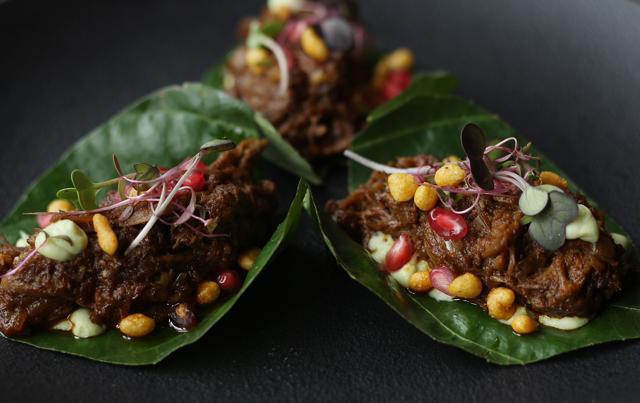For centuries, Indians have used the leaf-wrapped cooking technique which, sadly, is fading out of our kitchens. As the buzz around healthy and organic eating gains momentum, let’s look at this ancient cooking tradition that is now being documented by Ashoka University’s InHerit project.

Unwrapping India’s Culinary Heritage:
I have not read Ni’matnāmah Naṣir al-Dīn Shāhī, a late 15th-century book of the recipes of the eccentric Sultan of Mandu. Quite like several mediaeval Indian tomes, the Ni’matnāmah also mentions elaborate cooking processes including leaf-wrapped cooking technique – meatballs wrapped in lime leaves, and seasoned minced meat wrapped in screw pine leaves. I have not read the Ni’matnāmah, but I remember my father’s khansama (cook) sedulously wrapping rice batter, coconut and jaggery in turmeric leaves and steaming them into a scrumptious dessert. Or, arranging meat, rice and other vegetables in cabbage leaves and simmering them over low heat for hours. And on special occasions, slathering colocasia leaves with a gram & rice flour spicy batter and then deep frying them after a long steam bath. The khansama carefully picked leaves for different dishes according to the aroma and texture – banana, colocasia, turmeric, banyan and jackfruit to teak, sal, banyan, almond and screw pine.

My idea – and taste – of leaf-wrapped cooking technique was then limited to whatever was rustled in our ancestral kitchen, but leaves have been part of the Indian culinary tradition for centuries. There’s Odisha’s Enduri Pitha (Haldi Patra Pitha) in which a mixture of black gram and rice flour paste mixed with jaggery, black pepper and cottage cheese is stuffed in fresh turmeric leaves and steamed in earthen pots. In Goa, a similar dish called Patoleo or Patholi is made with rice flour paste, grated coconut and jaggery wrapped in turmeric leaves and steamed. In Bengali, pata means leaf, and from this, the word paturi originates. Leaves ranging from banana to ash gourd are used to make chingdi paturi, bhetki-maach er paturi, ilish paturi. In the South, Kancheepuram idlis are traditionally steamed in a bamboo basket lined with kachnar (mountain ebony) leaves while in Manipur, turmeric leaves are used for a dish called Paknam. In Karnataka, Karimeen Polichathu is made with teak leaves and in Rajasthan, leaf-wrapped cooking method was combined with khad (pit) cooking in which animals were wrapped in large leaves and cooked in fire pits.
Leaf-Wrapped Dishes:
Unfortunately, the traditional method of leaf-wrapped cooking is being forgotten. In a bid to document India’s heritage, Ashoka University, the Young India Fellowship Program and The Helen Hamlyn Trust (UK) have initiated InHerit, a project that aims to reconnect Indian youth to their heritage. Started in October 2023, the current season of InHerit is focusing on Culinary Heritage and Natural Heritage.
According to InHerit scholars, there are at least 40 different documented varieties of leaf-wrapped dishes across India. For the project, team InHerit has focussed on two different leaf-wrapped dishes – Patot Dia Maas, a dish from Assam, where fish marinated with garlic, green chilli, coriander and oil is wrapped in turmeric or banana leaf and cooked over the stove, and Moode, where idli batter is poured over a cylindrical cup made out of screw pine leaves, and steamed inside the cooker. Inherit’s 2nd Visual Series episode documents these two dishes – in Kaziranga (Patot Dia Maas) and Mangalore (Moode) – and conveys how culinary heritage can be passed down vertically through generations and shared laterally through peers.
“Each leaf has its unique properties like textures and subtle flavours, that get imparted to the dishes. The choice of leaves is also flexible as leaves are seasonal, and depends on certain factors like shape and strength of the leaf,” says Dharani Dhavamani (Young India Fellow 2023) and project leader.
Dhavamani, however, laments the dying culinary tradition. “Varieties like mantharai keerai, agathi keerai, ponnanganni keerai, karisalanganni keerai were a very common part of the kitchen vocabulary till just one generation ago. And now, most of them have faded away,” says Dhavamani.

Not only is the leafy cooking technique being forgotten, even the consumption of leaves is dwindling. According to culinary experts, Sadaf Hussain and Yuvan Aves, an urban dweller consumes different combinations of the same five leaves – spinach, cabbage, amaranth, mustard and fenugreek. Compare it with the Assamese Mising tribe that consumes 101 different varieties of leaves, specially on Rongali Bihu, the Assamese New Year, when families go to the forests and nearby hills to collect 101 species of herbs/leaves. Some of the leaves include Bhedai-lota (skunk vine), Duron bon (Leucas plant), Kola kosu (colocasia) and Tengesi Tenga (Indian sorrel). They believe that each of the leaves have a special medicinal property. Elderly matriarchs of the families knew which leaf to consume for which ailment, be it gut problems, rheumatism, skin allergies or urinary tract infections.
In Jharkhand, tribal communities forage for leaves from forests and integrate them in their diet. Apart from spinach, their gardens also have leaves like laal saag (red spinach), pui/poi (Malabar spinach), bathua (pigweed), dill, china, kado, karmi, sunsunia, netho, gundar, chiniya radish, golgala, etc. Dried moringa leaves are commonly available in Jharkhand’s traditional village markets and noni (wild purslane) is still an essential for Jivitputrika (commonly known as jitiya) festival. Despite urbanisation, these communities are still functioning as custodians of the ‘leafy’ culinary tradition.
However, due to urbanisation, climate change and lack of documentation, the leaves that were once an integral part of the kitchen are no longer available and such knowledge systems have become endangered, according to the InHerit findings.
Next time you eat a dish wrapped in a leaf, remember to respect the ancient culinary tradition and ensure that it is not forgotten.


